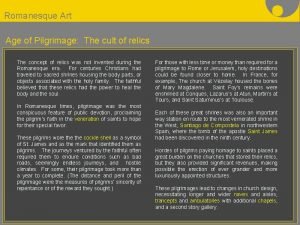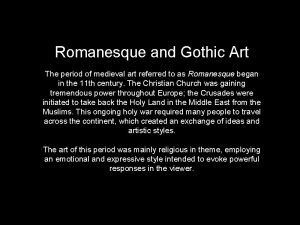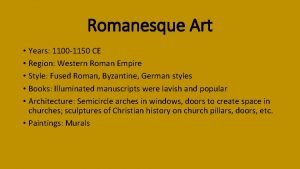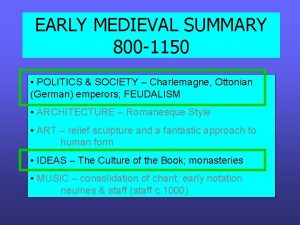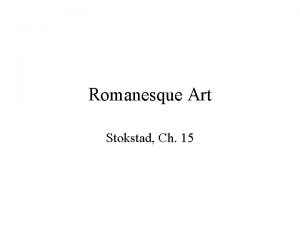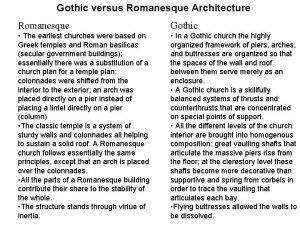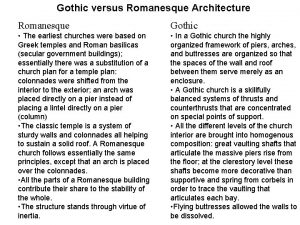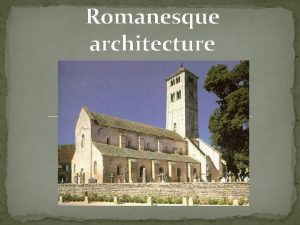Romanesque Art Years 1100 1150 CE Region Western











- Slides: 11

Romanesque Art • Years: 1100 -1150 CE • Region: Western Roman Empire • Style: Fused Roman, Byzantine, German styles • Books: Illuminated manuscripts were lavish and popular • Architecture: Semicircle arches in windows, doors to create space in churches; sculptures of Christian history on church pillars, doors, etc. • Paintings: Murals







Read the Khan Academy Article about the Church of Sainte-Foy https: //www. khanacadem y. org/humanities/ap-arthistory/early-europe-andcolonialamericas/medievaleurope-islamicworld/a/church-andreliquary-of-saintefoyfrance

Bayeux Tapestry, c. 1066 -1080 CE. Embroidery on linen.

Measuring twenty inches high and almost 230 feet in length, the Bayeux Tapestry commemorates a struggle for the throne of England between William, the Duke of Normandy, and Harold, the Earl of Wessex (Normandy is a region in northern France). The year was 1066—William invaded and successfully conquered England, becoming the first Norman King of England (he was also known as William the Conqueror). The Bayeux Tapestry consists of seventy-five scenes with Latin inscriptions (tituli) depicting the events leading up to the Norman conquest and culminating in the Battle of Hastings in 1066. The textile's end is now missing, but it most probably showed the coronation of William as King of England. The imagery and inscriptions are embroidered using wool yarn sewed onto linen cloth. The artists skillfully organized the composition of the tapestry to lead the viewer's eye from one scene to the next and divided the compositional space into three horizontal zones. The main events of the story are contained within the larger middle zone. The upper and lower zones contain images of animals and people, scenes from Aesop's Fables, and scenes of husbandry and hunting. The seventy-five episodes depicted present a continuous narrative of the events leading up to the Battle of Hastings and the battle itself. A continuous narrative presents multiple scenes of a narrative within a single frame and draws from manuscript traditions such as the scroll form.

The Bayeux Tapestry was probably made in Canterbury around 1070. Because the tapestry was made within a generation of the Norman defeat of the Anglo-Saxons, it is considered to be a somewhat accurate representation of events. Based on a few key pieces of evidence, art historians believe the patron was Odo, Bishop of Bayeux. Odo was the half-brother of William, Duke of Normandy. Furthermore, the tapestry favorably depicts the Normans in the events leading up to the battle of Hastings, thus presenting a Norman point of view. Most importantly, Odo appears in several scenes in the tapestry with the inscription ODO EPISCOPUS although he is only mentioned briefly in textual sources. By the late Middle Ages, the tapestry was displayed at Bayeux Cathedral, which was build by Odo and dedicated in 1077, but its size and secular subject matter suggest that it may have been intended to be a secular hanging, perhaps in Odo’s hall.




